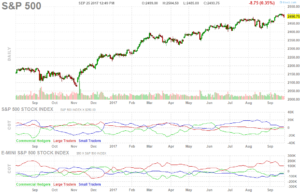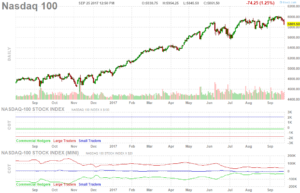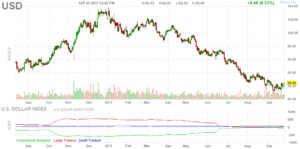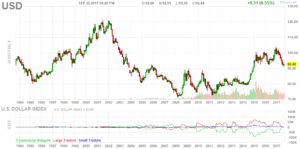Today notwithstanding (the S&P 500 is off 0.50% and the NASDAQ 100 is off almost 1.50% today, Monday, September 25, as I write this), stocks have been in a bull market since President Trump’s election, and particularly since 1/1/17. Through the close on Friday 9/22/17, the SPY (the S&P 500 ETF) was up almost 11.6% YTD in 2017, and the QQQ (the NASDAQ 100 ETF) is up a whopping 21.8%. Those are great returns!
Why?
Media types have tried to explain the market’s rise various ways. Proffered explanations have included the following:
- Corporate profits are up due to better management at companies.
- Bank profits are up due to a favorable interest rate environment.
- GDP growth is expected to be enhanced by tax reform.
- A proposed infrastructure spending bill will prime economic growth.
- Stocks are benefiting from a weaker US Dollar.
In my opinion, all of these explanations have merit, but I believe the last one – the weakening US Dollar – has been the biggest source of fuel that has propelled the stock markets upward since 1/1/17.
Charts
Here is a daily chart of the SPY for the past year. Pay particular attention to the period since 1/1/17:

Here is a daily chart for the NASDAQ 100:

As you can see, both of these have followed similar patterns: Up. Good for investors. Investors who invest in index ETF’s have done well. Value investors – those looking for companies that they believe are undervalued – may have done okay, or they may have not, depending on what they have invested in.
Now look at a daily chart of the US Dollar Index, which is the US Dollar vs. a basket of other major world currencies:

From Trump’s election through the end of 2016, the Dollar and the stock market both moved up. Since January 1, however, the Dollar and the stock market has moved in opposite directions. Stock Market – Up; Dollar – Down. I believe the dollar’s devaluation has been the main reason for the rise in stocks.
Why? – Part 2
Why has the Dollar gone down? Several reasons, in my opinion:
- The dollar was previously overvalued, and the decline since 1/1/17 has been somewhat of a mean reversion.
- Economies in other countries have improved, relative to the US economy. Remember the Greece economic crisis? Which was supposed to be followed by Portugal, Spain, and Italy going under and sinking the EU and the Euro? And finally Brexit? Well, none of the worst case scenarios have yet come to pass. European economies have come out of their crisis, and the EU’s condition has certainly been upgraded from Situation Critical, if not fully healthy.
- Medium and long-term interest rates in the US have declined relative to the rest of the world, even while the Federal Reserve has increased short-term rates. The yield curve has flattened.
- The Trump Administration wants a weaker dollar in order to boost US exports. The weaker dollar means US goods are less expensive in other countries. This may be good in the short-term but is a bad national policy in the long-term.
Why? – Part 3
Why has the Dollar’s devaluation caused an increase in stock prices? It all boils down to this: If the Dollar is not worth as much, then it takes more dollars to purchase something, including stocks. It’s a form of inflation.
Currencies are like a supertanker – they don’t turn on a dime, and once they move in a certain direction, they tend to keep moving in that direction. Therefore the Dollar’s recent decline may be part of a longer-term shift. Below is a monthly chart of the US Dollar, on which you can see that the Dollar’s trends take a long time to play out:

Or, the Dollar’s decline may reverse and go back up again. If I knew, I would bet the farm on it. I don’t know, but I believe the decline in the Dollar explains why the stock markets have gone up this year. I will continue to believe this until I see evidence that it isn’t true anymore.
